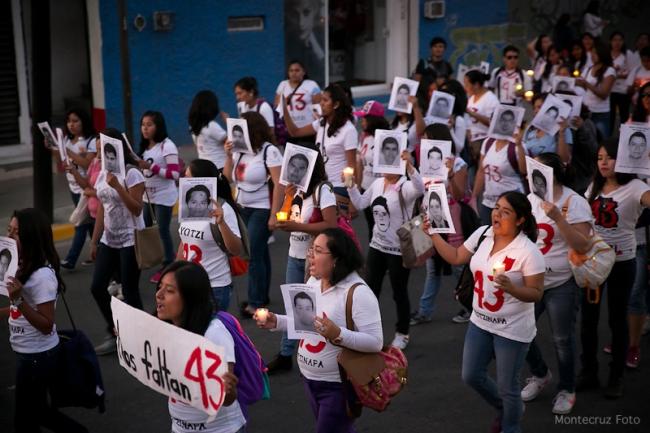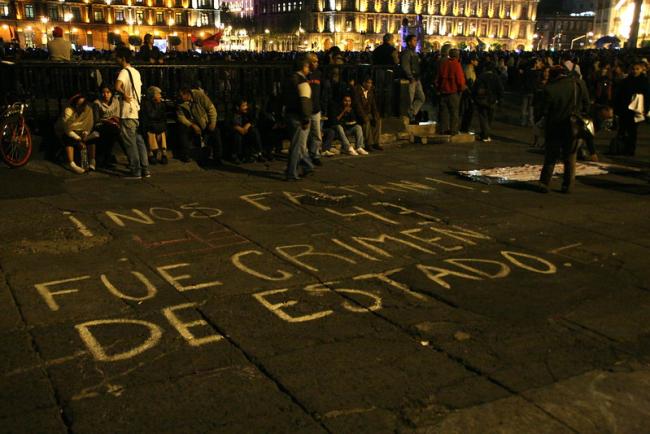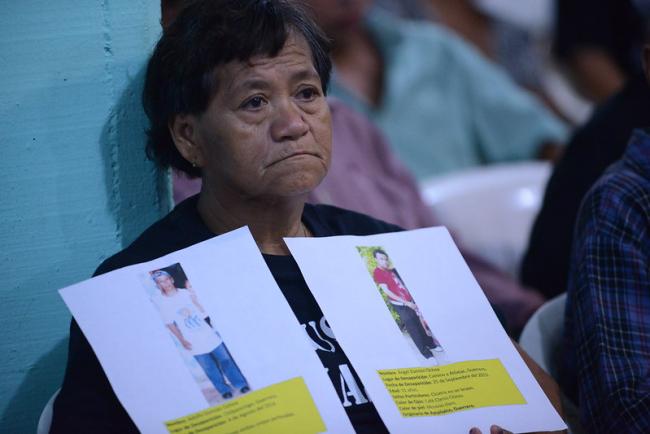
On the night of September 26 to 27, 2014, in Iguala, Guerrero, police intercepted more than 60 students from the Rural Teachers’ College of Ayotzinapa as they traveled on buses bound for Mexico City to attend the Tlatelolco massacre anniversary march. Forty-three of the students were disappeared, and dozens more were injured. The Ayotzinapa 43 and the ensuing cover-up put Mexico’s crisis of forced disappearance in the international spotlight like never before.
Today, the case remains in impunity, while Mexico's crisis of forced disappearance continues unabated. Outgoing president Andrés Manuel López Obrador promised on the campaign trail in 2018 to solve the case. However, in July, as his term neared its end, he described Ayotzinapa as an “open file,” still under investigation a decade later. During his six years in office, the president clashed with human rights organizations and undermined efforts to get to the bottom of the case. Families of the disappeared have accused him of shielding the military.
Claudio Lomnitz, a Chilean-Mexican anthropologist and professor at Columbia University, has studied disappearances in Mexico and beyond for decades. As AMLO’s successor Claudia Sheinbaum prepares to assume office on October 1, Lomnitz offers crucial insights. Tens years and two presidential administrations after chants of “They took them alive; we want them back alive” erupted, key questions remain: What happened in Iguala, what did it mean, and why has the search for truth repeatedly faltered? What does it all say about present-day Mexico and the Mexico to come?
I spoke to Lomnitz over the phone in early September. Our conversation has been translated from Spanish and edited for length and clarity.
Lucía Cholakian: Recently, I was told that to understand disappearances in Mexico, I had to abandon everything I know as an Argentine. Let's delve into that: how can the phenomenon of disappearances in Mexico be explained? What are the specific characteristics of disappearances there?
Claudio Lomnitz: Disappearance is a moment in a process. When disappearance is part of a murder, there is a decision to make the person who is murdered disappear. The motivations for disappearing the body can range from wanting to punish the families or their community—because when someone disappears, it is often a lifelong sentence of uncertainty for the family—to avoiding the murdered person being counted in official statistics.
Disappearance can also be a form of kidnapping, generally for forced labor. The most common cases involve the recruitment of soldiers for the drug trade. But some people are kidnapped to work as accountants, doctors, or IT professionals due to the significant growth of groups like Los Zetas. Also cooks and construction workers. I have the impression that most of these people end up being murdered. This type of disappearance is related to the dynamics of wars and to the economic dynamics of organized crime.
In many cases, as was the case in Argentina and often in Mexico, it could be the police or the army behind the disappearance. There is a desire to leave no trace of the incident. And sometimes, there is a gesture of collusion between an organized crime group and governmental allies.
LC: Do you think disappearance is also an end in itself in Mexico? Or is it “just” a vehicle for impunity?
CL: That’s an excellent question, and I’m not sure of the answer. I think there may be cases where disappearance is precisely the goal. There are a significant number of cases where it is explicitly intended to prevent family members or the community from having the opportunity to bury their loved ones. I think these cases do show disappearance as an end in itself. A disappearance ultimately removes someone not only from being counted as a person, but also from engaging in narratives, testimonies, or experiences that could construct truth. In that sense, sometimes in Mexico it does resemble disappearance in Argentina, Chile, Uruguay, and elsewhere.
LC: How do the 43 students from Ayotzinapa fit into these dynamics?
I have the impression that, at least initially, they were disappeared because the situation was spiraling out of control. Events escalated, and the disappearance was initially aimed at preventing these events from unfolding, but it ended up having a counterproductive effect.
When they began searching for the 43 students, 18 or 19 mass graves appeared, which, in my opinion, have scandalously not been addressed in Mexican politics, as if the bodies in those graves do not count. We have the magic number 43, and a completely vanished number of people in those other graves.
Ayotzinapa has brought the issue of disappearances in Mexico to the international forefront. Yet, it does not seem to have changed the course of things regarding the search for the disappeared.
It has been very interesting—and sad—that the social movement that emerged from this did not manage to create transitional justice. It could have happened, but it did not. The obsession with the 43 has tended to become a propaganda tool that the government uses to show that it is doing something. A disproportionate number of resources have been allocated to this case compared to the truly gigantic scale of disappearances in Mexico. This fact makes the issue more manageable, both narratively and investigatively. Even if they haven’t managed it perfectly, it’s still more manageable [than disappearance writ large].
Compare, for example, Ayotzinapa with the San Fernando case [in which Los Zetas abducted and massacred 72 migrants in Tamaulipas state in 2010]. That case is numerically much more significant than Ayotzinapa and, on some level, politically more relevant. It involved the monopolization of access to a part of the Mexico-U.S. border. Iguala is not that; Iguala is a city in the center of a poppy-producing region, but it is not a militarily strategic point like San Fernando. Journalist Marcela Turati has done extraordinary work in San Fernando to recover the stories from oblivion. Meanwhile, Ayotzinapa has become a pious truth, like passing by a church and making the sign of the cross.
It’s very straightforward: everyone wants to forget San Fernando, not Ayotzinapa.
LC: Your book, For a Theology of Organized Crime, discusses the interdependence between the state and organized crime. This interdependence is evident in Ayotzinapa. In other cases, it’s more elusive.
CL: Because we don’t know about it.
LC: We don’t know about it. AMLO came into office with a promise regarding Ayotzinapa, which has not been fulfilled. How has the relationship with organized crime been redefined during his presidency?

CL: One reason Ayotzinapa gained so much traction in 2014 is that the Mexican population wants to imagine the state as a well-articulated vertical structure. When it is said, “It was the state,” people want to believe that there is a state with a centralized decision-making process.
The Ayotzinapa case involved the state, but the state that was involved is not the state we would like to see. This is entirely different from the 1968 [Tlatelolco massacre], where the secretary of defense, the secretary of the interior, and the president of the Republic were directly involved. In the Ayotzinapa case, you’re talking about a municipal president, a municipal police force connected with certain actors, a military barrack, a state police force. It’s not a centralized decision.
In Mexico there is a strong desire, and I say this with all the sadness in the world, for a vertically integrated state. AMLO represents and embodies this desire for sovereignty through power concentrated in the presidency and in its allies, namely, the Armed Forces.
The problem with the relationship between organized crime and the state is that it is not a single relationship; it’s multiple relationships. There can be a relationship between a governor and a specific group, between a municipal president, a municipal police force, a barrack, a colonel, and a general. This reality makes the situation much more frightening. People are frightened and prefer not to see it, I think.
LC: You highlight in the book that AMLO rhetorically includes the illicit economy [organized crime] in the category of "the people," addressing them as such. This seems to be the opposite of some processes in other parts of Latin America, such as the Bukele government in El Salvador. Do you think this rhetorical strategy was effective?
CL: It is very positive and utterly deceptive. The positive side is that it does indeed address a broad illicit economy—these are not simply bad Mexicans or something like that. It is a political economy phenomenon that deserves serious attention and should be addressed through the law. However, AMLO’s phrase “hugs, not bullets” doesn’t work at all. It’s, like many political slogans, just a rhyme (abrazos no balazos).
The Bukele approach resonates so strongly because it is immanent. If you have, as in Mexico, increasing militarization and suddenly see murders and brutality, you are tempted to say: do something. It’s immanent. Sometimes they do something, and sometimes they don’t.
Recently, Crisis Group released a crucial report that passed without much notice, as is often the case in Mexico. The report documents that the Army had significant confrontations with the Jalisco New Generation Cartel in Michoacán, resulting in 400 deaths. The cartels—some allied with the Armed Forces, others opposed to Jalisco, and those benefiting from the state’s intervention—disappeared these 400 people to cover up the increase in homicides. This occurred during AMLO’s presidency, and people do not complain, partly because the deaths were of people from the Jalisco Cartel, which has been terrible. People were probably relieved that the Army intervened and confronted the cartel.
This is what I mean when I say it’s immanent. It may not be a state policy, but it is always possible when you have that degree of militarization. AMLO’s insistence that organized crime members are part of the people might somewhat mitigate this trend, but it does not eliminate even his ability to pursue it.
LC: In a 2015 article, while President Enrique Peña Nieto was still in office, you expressed little faith that the issue of disappearances in Mexico would be resolved, primarily due to the role of the state in the disappearances. Do you still hold this view?

CL: I am sure there must be a way for this to end; the fact that I don’t see it doesn’t mean much. I don’t make public policy. We are dealing with a highly complex problem. It requires extensive work involving many people and various types of expertise. It requires an understanding that it will take a collective effort. It is a very tangled web precisely because of the nostalgia for a centralized state. Violence is not the product of a centralized state but is deeply intertwined with the state. The state is either involved, an ally, or absent.
At the same time, the absent state is not bureaucratically articulated. The capacity for endemic, decentralized, occasional, yet chronic violence is very high, and that’s what we must face.
AMLO thought—and this is where I am very critical—that it [violence in Mexico] was a problem of poverty and social programs and that he could resolve it. There is no doubt that social programs are necessary. But which programs? For what purpose? For whom? Undoubtedly, poverty is part of the backdrop, but it is only part of it. What’s needed goes beyond an ideological pronouncement; empirical work is necessary. That empirical work, so far, has been done by those on the front lines in Mexico: journalists. And at great personal cost. There are also cases involving sociologists and anthropologists, but much work remains to be done from various angles.
LC: Do you envision a “Never Again” movement in Mexico at some point?
CL: I do not envision it. I thought Ayotzinapa could have been a springboard for something like that, though with difficulty. Maybe. But now, I don’t see it. I don’t see a transitional justice outcome. I don’t see a “Never Again” movement because it requires a political context.
Unfortunately, we have a sort of normalization, an attempt to downplay the issue. If you talk more and more about disappearances, murders, and extortion, you are portrayed as an opponent of the government. There is an ideological skewing of the issue. We are in a very delicate moment.
LC: So, there is no hope, then?
CL: There is hope, but I wouldn’t know how to build it right now.
Lucía Cholakian Herrera is a freelance reporter from Buenos Aires covering politics and human rights in Latin America.

